This experience with Greater Sage Grouse was one of my most memorable in the field.
I’ve posted images of some of these birds previously but all of these are new to my blog.
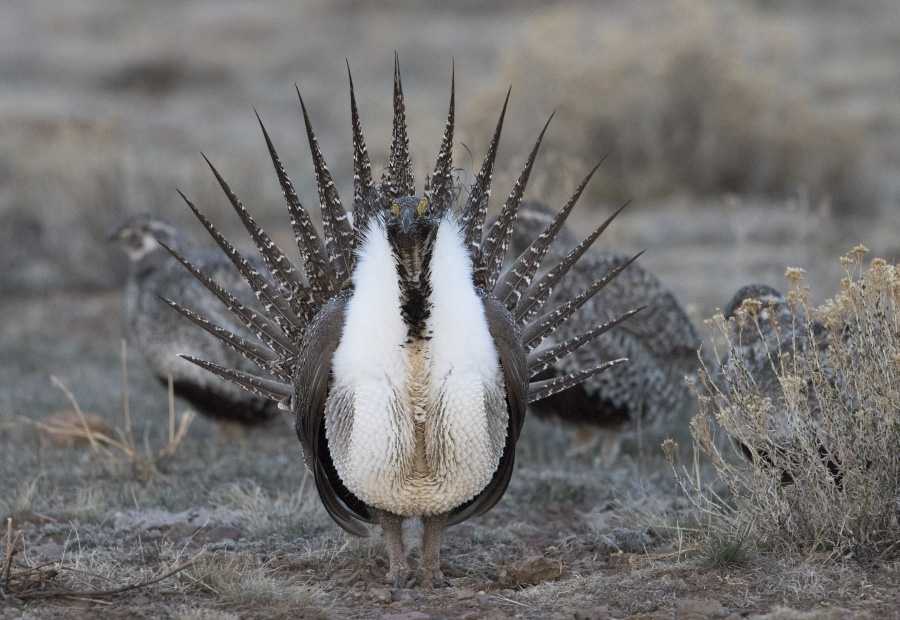
1/400, f/6.3, ISO 3200, Canon 7D, Canon EF500mm f/4L IS II USM +1.4 tc, not baited, set up or called in
This past May I was near a lek in very early morning on Utah’s Aquarius Plateau. It was long before sunrise when I first arrived so I was really testing the ISO performance of my relatively new Canon 7D Mark II and in the end I thought it significantly outperformed my previous 7D. It was still quite dark when these first two images were taken.
Here a male is strutting for three females in the background.
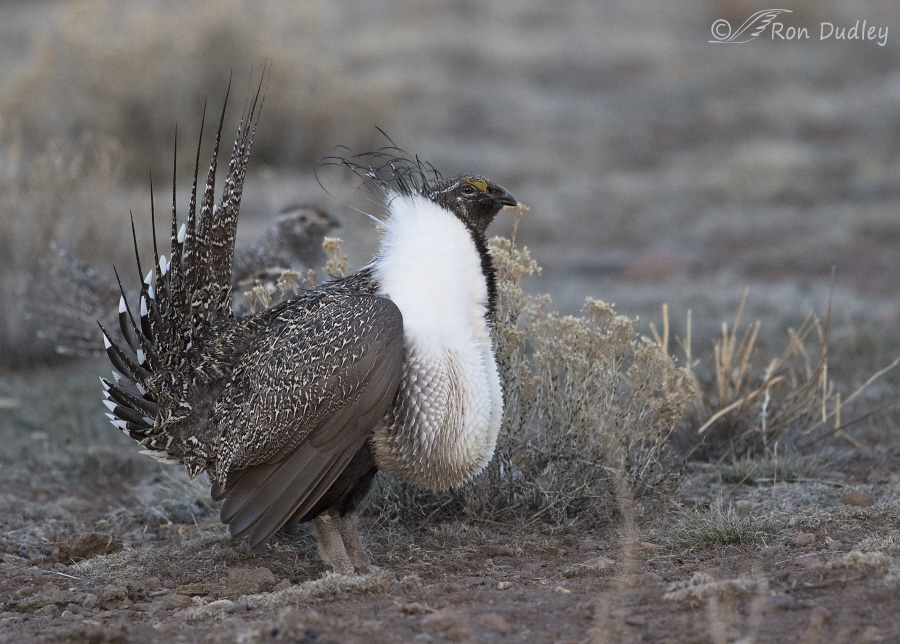
1/400, f/6.3, ISO 3200, Canon 7D, Canon EF500mm f/4L IS II USM +1.4 tc, not baited, set up or called in
In this image I like the strategic placement of the head of one of the females as she watches the performance intensely.
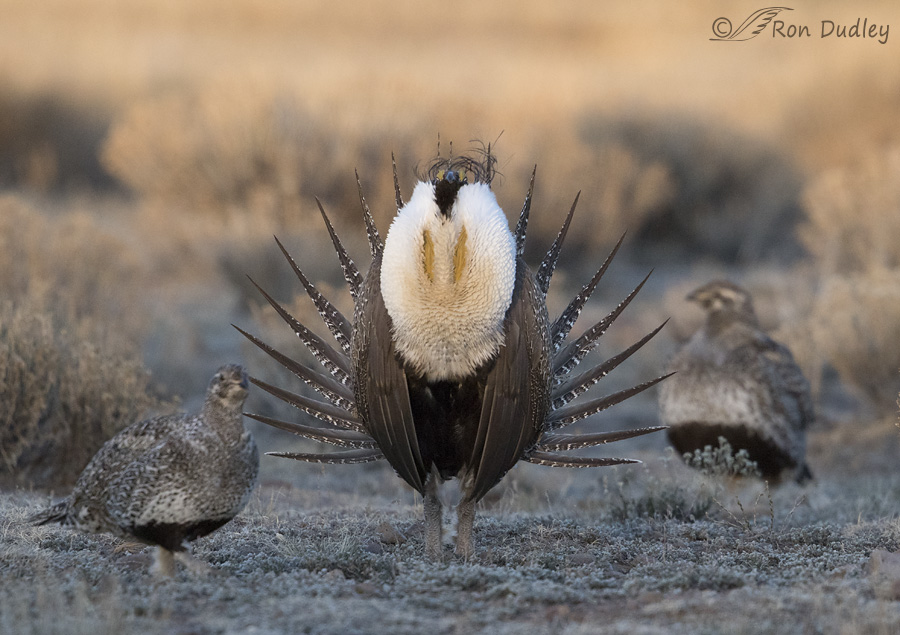
1/800, f/6.3, ISO 2000, Canon 7D, Canon EF500mm f/4L IS II USM +1.4 tc, not baited, set up or called in
Finally, some of the light from the rising sun began to light the scene as the males continued to dance. The diffuse brightness in the eastern sky caused the catch lights in the eyes of the male to look a little eerie.
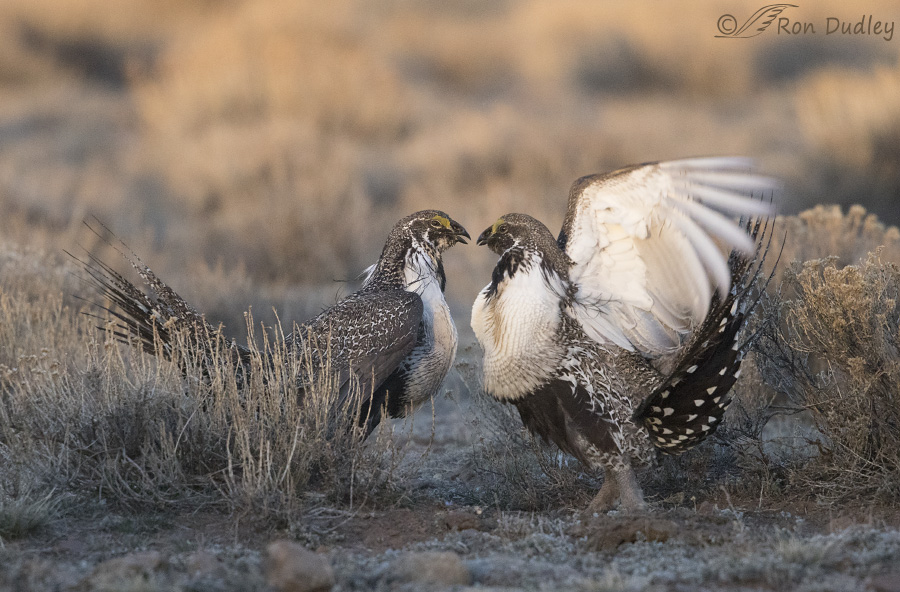
1/1600, f/5.6, ISO 4000, Canon 7D, Canon EF500mm f/4L IS II USM +1.4 tc, not baited, set up or called in
Occasionally two of the males would square off as a prelude to combat and it was a real challenge to come even close to freezing the action in this light. Their weapon of choice was their wings and the wing-slapping was usually too fast to freeze, even at these very high ISO’s. They also did a lot of biting and claw-scratching.
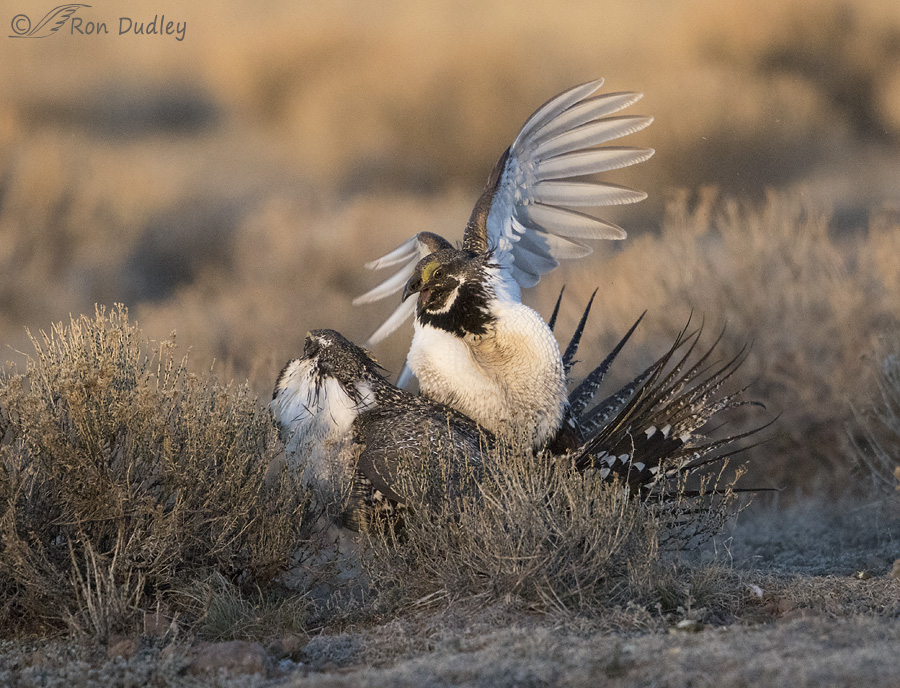
1/2500, f/5.6, ISO 4000, Canon 7D, Canon EF500mm f/4L IS II USM +1.4 tc, not baited, set up or called in
Eventually there was enough light to get those furiously flapping wings fairly sharp.
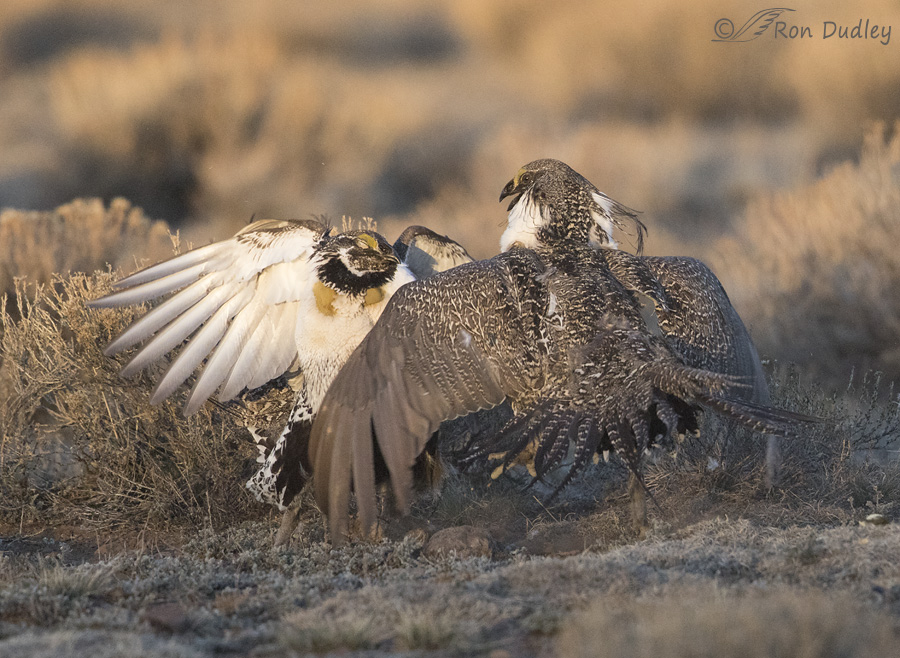
1/2500, f/5.6, ISO 4000, Canon 7D, Canon EF500mm f/4L IS II USM +1.4 tc, not baited, set up or called in
The bird on the left seemed to be the less skilled fighter and bore the brunt of the blows. Here he is recoiling from one of the slaps.
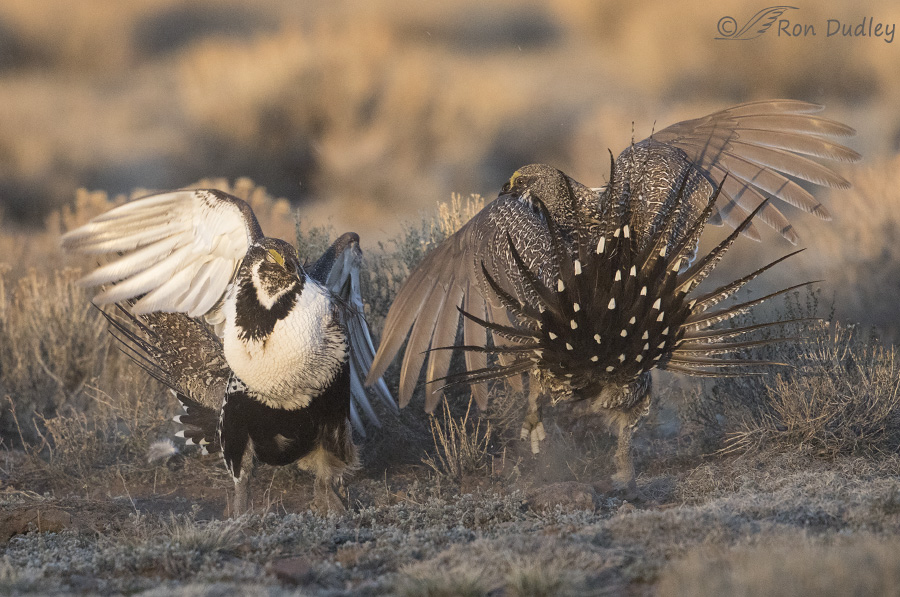
1/2000, f/5.6, ISO 4000, Canon 7D, Canon EF500mm f/4L IS II USM +1.4 tc, not baited, set up or called in
That bird seemed to have its eyes closed much of the time, either in response to, or in anticipation of, another wing-strike from its rival.
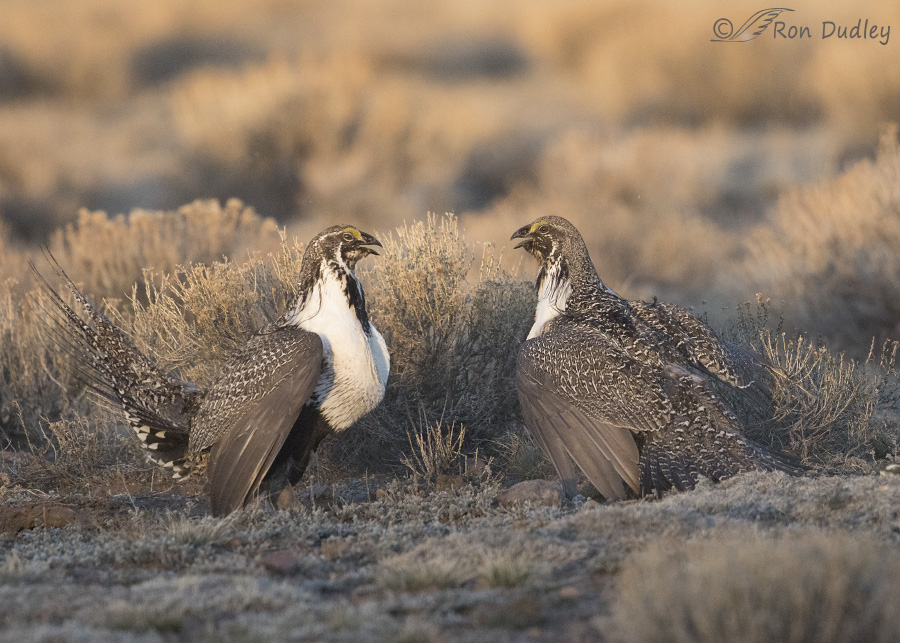
1/2000, f/5.6, ISO 4000, Canon 7D, Canon EF500mm f/4L IS II USM +1.4 tc, not baited, set up or called in
The fighting bouts were intense but they spent most of their time squared off in threatening poses like this, similar to two prize fighters at the weigh-in prior to a boxing match. I almost expected Don King to appear between the two birds…
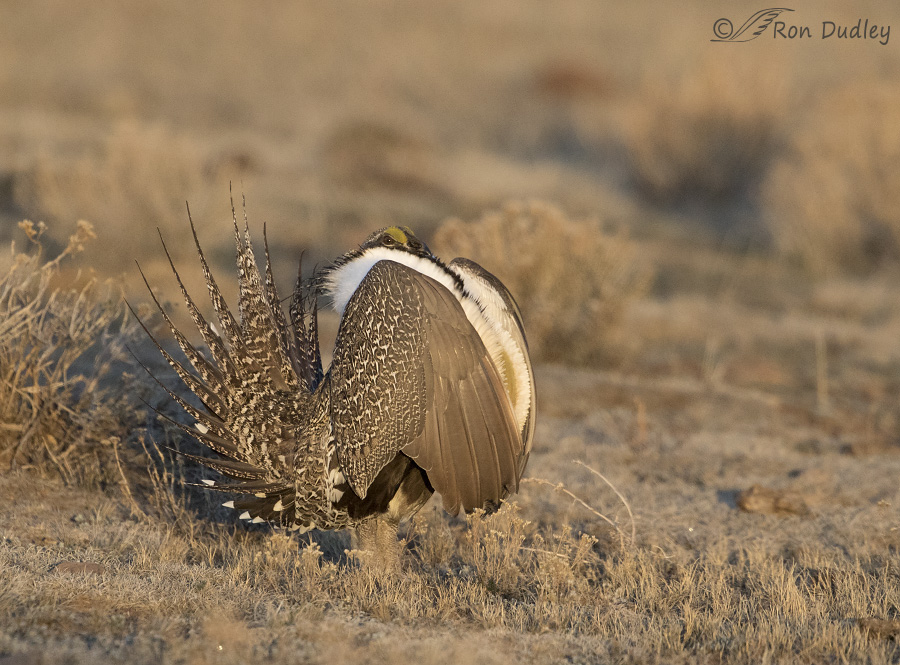
1/1250, f/6.3, ISO 1600, Canon 7D, Canon EF500mm f/4L IS II USM +1.4 tc, not baited, set up or called in
But both birds eventually returned to their own display ground and began to perform for the females once again.
The grouse stayed on the lek for about another 40 minutes after this shot was taken and then slowly dispersed, usually in small groups. Some of them flew off and others just slowly wandered away.
Ron


Spectacular shots Ron!
Thanks so much for sharing them!!
Charlotte
Wonderful sequence Ron. Spectacular shots of spectacular birds! Their plumage is incredible!
That catchlight looks so weird I bet you could sell it as an image of an alien if you cloned out the females in the background. It made me smile as I imaged people’s guesses about what was in the desert and where di it come from.
Yeah, those catch lights make him look a little spooky, don’t they, Pam?
Catch lights can be weird – from typical pinpoints, to broad diffuse ones, to double or triple ones – it goes on and on. When I’m close to the bird I can often see myself (my pickup usually) as a reflection in the eye when I blow the image up.
I’ll bet it’s fascinating to watch Greater Sage Grouse square off with each other or dancing. I’m sure these photos only tell the barest outlines of the story. Very interesting, as always.
You’re right on both counts, Susan. Thank you.
What an amazing sequence. You must have been filled with awe to actually see (and hear) it. Despite the cold. I love that the females were watching too. I have seen many a male displaying (but not fighting) where the female obviously couldn’t care less…
I have to ask though – chaining the sage? Explanation please. I understand it is a destruction of their natural habitat (something our species does with reckless and thoughtless abandon) but chaining? Does this describe how it is done? Or is it a local term?
EC, “Chaining” is when a huge, long chain is dragged between two big tractors (or other pieces of heavy equipment) to tear vegetation out of the ground. It’s done to sagebrush in particular but it also used to be done to juniper forests. In the latter case each link in the chain could weigh as much as a hundred pounds or more. It’s incredibly destructive.
Chaining destroys everything in its path…of course sage, and other plants, including junipers, small pines, wildflowers, creosote, rabbit brush, etc. the nests of ground nesting birds, food (ex.the sage/sage grouse food), cover and the plants whose roots combat erosion by wind and water…calling it “destructive” is almost a euphemism….as far as the “face” of the American West is concerned, it can be compared to a clumsy facelift gone terribly wrong…to see it is devastating…
Thank you both.
I despair of our race and its greed and its short-sightedness so often. I suspect the world would be better off without us.
All I can say is WOW and that camera handles the higher ISO quite well.
I was pleased with the high ISO performance of the Mark II, Jo. Normally I have to be dragged kicking and screaming into ISO territory faster than 800.
What a wonderful sequence to capture! I’m surprised that either of the combatants can fight yet still manage to keep their ruffs and spikey tail. feathers erect…I only hope this fascinating behaviour and display can continue for other generations to witness and enjoy…they’re so rapidly running out of space due to reckless over-development, destruction of habitat and, especially, chaining of sage…
You and I often have the same thoughts, Patty and I also wondered how their tail feathers stayed in such great shape – especially over the many weeks they do this.
Great sequence. I don’t think Don King gets up that early. “…one of my most memorable in the field.” I’ve only had one chance to observe Sage Grouse on their lek. The associated snow and cold probably helped seal the memories.
I suspect you’re right about Mr. King, Dave. We didn’t have snow but it sure was cold.
Terrific sequence of photos, Ron. This must have been wonderful to be there. And very exciting to photograph these behaviors. Thank you for letting us see this world.
Wonderful it was, Deborah. Very cold but wonderful.
Wonderful sequence! 🙂 Looking at the commentary, ISO, and shutter speed it really gives a sense of how fast it’s happening. Love the detail and the story told.
Yup, fast action and low light isn’t a good combination for photography, Judy. I compensated as best I knew how.
Ron, these captures are just wonderful and your commentary also brought back memories of “The Sagebrush Sea”. What was so surprising was that so few of all those males competing would actually mate!! The majority of the females would mate with just a few males, trying to get the best genes for their chicks. It must have been quite a thrill for you to observe all their mating rituals!! I enjoyed your series so much because of that special.
I also watched “The Sagebrush Sea” and enjoyed it very much, Jo Ann. Thank you.
“I’ve had the opportunity to watch Sage Grouse in the early morning and it’s something you don’t forget.”
Boy, isn’t that the truth! Thanks, Marya.
Wonderful pictures, Ron! Thank you for sharing them. I’ve had the opportunity to watch Sage Grouse in the early morning and it’s something you don’t forget.